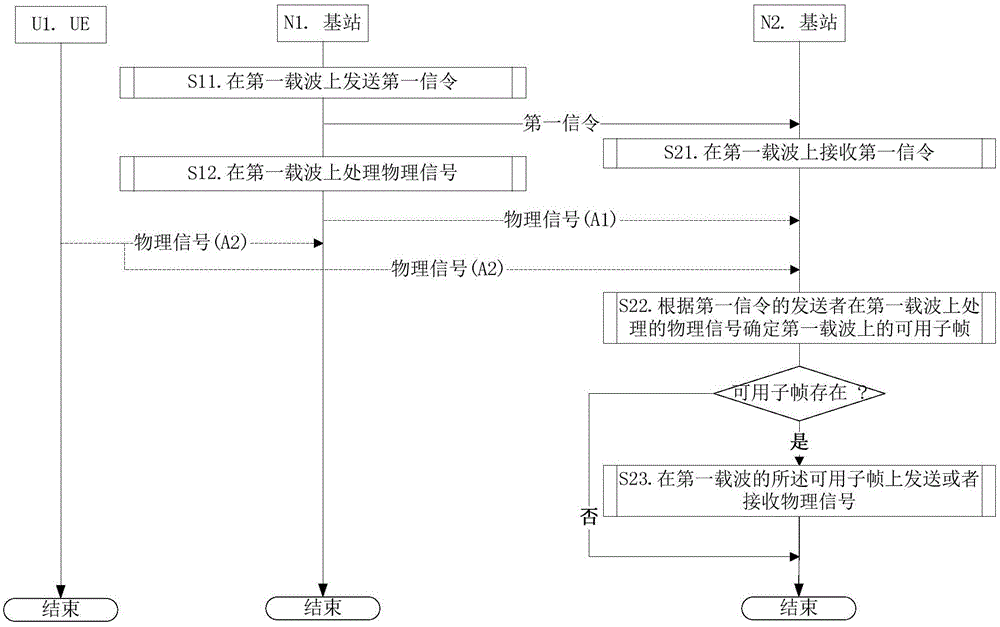Method and apparatus for communication on non-authorized frequency band
An unlicensed spectrum and signaling technology, applied in wireless communication, electrical components, etc., can solve problems such as interference
- Summary
- Abstract
- Description
- Claims
- Application Information
AI Technical Summary
Problems solved by technology
Method used
Image
Examples
Embodiment 1
[0077] Embodiment 1 illustrates the coordination flowchart between base stations deployed on the same unlicensed spectrum wave, as shown in the attached figure 1 shown.
[0078] for base station N1 , in step S11, the first signaling is sent on the first carrier, the first signaling indicates one or two of a positive integer N and a rational number R, and the R is not less than 0 and not greater than 1; in step S12 , process the physical signal on the first carrier.
[0079] for base station N2 , in step S21, the first signaling is received on the first carrier, the first signaling indicates one or two of a positive integer N and a rational number R, and the R is not less than 0 and not greater than 1; in step S22 , determine the available subframe on the first carrier according to the physical signal processed by the sender of the first signaling on the first carrier; if the available subframe exists, in step S23, the available subframe on the first carrier A physical si...
Embodiment 2
[0090] Embodiment 2 illustrates a schematic diagram of the time domain position of the first signaling, as shown in the attached figure 2 shown. attached figure 2 In , the squares marked with slashes are transmission subframes of the first signaling.
[0091] For the first base station, first send the first signaling on the first carrier, the first signaling indicates one or two of a positive integer N and a rational number R, and the R is not less than 0 and not greater than 1; then in the first The physical signal is processed on the carrier.
[0092] For the second base station, the first signaling is first received on the first carrier, and the first signaling indicates one or two of a positive integer N and a rational number R, and the R is not less than 0 and not greater than 1; then according to the first The physical signal processed by the sender of the signaling on the first carrier determines the available subframes on the first carrier.
[0093] In Embodiment...
Embodiment 3
[0096] Embodiment 3 illustrates yet another schematic diagram of the first signaling time domain position, as shown in the attached image 3 shown. attached figure 2 In , the square marked by the backslash is the transmission subframe of the signature sequence, and the bold square is the transmission subframe of the physical layer information block.
[0097] For the first base station, the first signaling is first sent on the first carrier, the first signaling indicates a positive integer N and a rational number R, and the R is not less than 0 and not greater than 1; then the physical signal is processed on the first carrier.
[0098] For the second base station, the first signaling is first received on the first carrier, the first signaling indicates a positive integer N and a rational number R, and the R is not less than 0 and not greater than 1; then according to the sender of the first signaling in Physical signals processed on the first carrier determine available subf...
PUM
 Login to View More
Login to View More Abstract
Description
Claims
Application Information
 Login to View More
Login to View More - R&D
- Intellectual Property
- Life Sciences
- Materials
- Tech Scout
- Unparalleled Data Quality
- Higher Quality Content
- 60% Fewer Hallucinations
Browse by: Latest US Patents, China's latest patents, Technical Efficacy Thesaurus, Application Domain, Technology Topic, Popular Technical Reports.
© 2025 PatSnap. All rights reserved.Legal|Privacy policy|Modern Slavery Act Transparency Statement|Sitemap|About US| Contact US: help@patsnap.com



